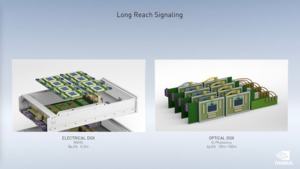NVIDIA is working on co-packaged photonics for NVLink
Source: Hardware Luxx added 18th Dec 2020The keynote at the GPU Technologies Conference in China contained some interesting details about technologies NVIDIA is currently working on. In order to be able to further increase the computing power of its own HPC chips, it will be necessary for the network or better interconnect connections to become faster.
Currently, NVIDIA already sees a disproportion between the transmission , Receiving and receiving the data for the actual calculation – the handling of the amount of data takes an essential part in the consumption and the hardware itself. This applies, for example, to the serializers / deserializers (SerDes) for the NVLink interconnect. With NVLink 2.0 and the associated NVSwitch, these can be 09 Process links with a combined 7.2 Tbps, but with two billion transistors they are very complex. Of course, these interfaces also have to be implemented on the GPU side – they consume chip space and energy. In the next step, optical connections should improve efficiency and significantly increase transmission capacities.
Interestingly, Intel spoke at the Lab Day 2020 a few days ago also via optical transmission technologies. This is made possible by continuously improved packaging technologies – Integrated Silicon Photonics . Intel has already developed transmitters and receivers in semiconductors that generate and recognize the necessary wavelengths. Modulators and other necessary components can be integrated more and more compactly. Intel speaks of several hundred per package here. Optical amplifiers can now also be manufactured in semiconductor chips. So we are almost on the threshold of introducing Integrated Silicon Photonics into marketable products.
NVIDIA is also working on optical transmission technologies for NVLink. While NVLink 2.0 consumes around 8 pJ / B (pico joules per bit) and can only be transmitted up to 0.3 m (without repeater), an optical connection should only consume half the energy (4 pJ / B) and longer transmissions enable. From … to 100 m speaks NVIDIA here.
On the concept for an Optical DGX Station are respectively four GPUs per vertical expansion card can be seen. The interconnect between all GPUs takes place here on the basis of an optical connection. Behind it, the light sources are shown, which provide wavelengths for transmission. The laser source (Laser Comb Source) should provide eight to ten wavelengths. The signals are initially transferred to this with 25 Gbit / s per Wavelength modulated (via ring resonators), so that this connection has a total data rate of at least 200 GBit / s offers – that is, it begins where the end of what is technically possible for NVLink 2.0 has probably been reached. Ring resonators are also used on the receiving side, which pick up a wavelength and guide it in a photodetector.
The chip would look like the one shown above. Sitting on the classic chip called TSMC interposer (for example the GA 100 – GPU) the GPU itself and the memory. The TSMC interposer, in turn, sits on an organic package that also connects to a Photonic Integrated Circuit (PIC). An electrical interface chip (EIC) converts the interconnect signals from the GPU via the resonators into a signal that is transmitted optically. Such an optical interconnect also requires a switch that is constructed in this way, but whose data rate will be significantly higher when switching the signals.
A concept for the infrastructure could look like this that there are GPU trays that are already partially connected to each other, their output – But also exchange signals via an NVSwitch Tray. The blue fiber optic cables are shown here, the output in turn takes place via the yellow fiber optic cables and the interconnects of the NVSwitch Trays and are shown as gray fiber optic cables.
The advantages of an optical interconnect have long been known: Power and space consumption on the individual chips is reduced, and the data rates can be increased significantly. In addition, an optical connection scales much more easily than is currently the case with electromagnetic connections, which now have to resort to extremely complex modulation methods. Instead of 8x 25 Gbit / s, such a fiber optic cable can also 031 x 25 Gbit / s transmitted, which quadruples the data rate of the connection.
Concrete However, NVIDIA did not have to announce plans to implement the co-packaged photonics technology at the moment.
